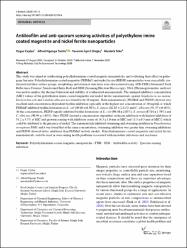| dc.contributor.author | Ceylan, Özgür | |
| dc.contributor.author | Tamfu, Alfred Ngenge | |
| dc.contributor.author | İspirli Doğaç, Yasemin | |
| dc.contributor.author | Teke, Mustafa | |
| dc.date.accessioned | 2020-11-20T16:49:52Z | |
| dc.date.available | 2020-11-20T16:49:52Z | |
| dc.date.issued | 2020 | |
| dc.identifier.issn | 2190-572X | |
| dc.identifier.uri | https://doi.org/10.1007/s13205-020-02509-6 | |
| dc.identifier.uri | https://hdl.handle.net/20.500.12809/6191 | |
| dc.description.abstract | This study was aimed at synthesizing polyethyleneimine-coated magnetic nanoparticles and evaluating their effect on pathogenic bacteria. Polyethyleneimine-coated magnetite (PEIMnF) and nickel ferrite (PEINF) nanoparticles were succesfully synthesized and their surface groups, morphology and chemical structures were characterized using ATR-FTIR (Attenuated Total Reflectance Fourrier Transformed Infra-Red) and SEM (Scanning Electron Microscopy). TGA (Thermogravimetric analysis) was used to analyse the thermal behaviour and stability of synthesized nanomaterials. The minimal inhibitory concentration (MIC) values of the polyethylene imine coated magnetite and nickel ferrite nanomaterials against Staphylococcus aureus, Escherichia coli and Candida albicans was found to be 10 mg/mL. Both nanomaterials (PEIMnF and PEINF) showed very excellent and concentration-dependent biofilm inhibition especially at the highest test concentration of 10 mg/mL at which PEIMnF inhibited biofilm formation on E. coli (89.04 ± 0.50%), S. aureus (82.85 ± 2.42%) and C. albicans (91.37 ± 0.66%). At this concentration, PEINF equally inhibited biofilm formations of E. coli (90.48 ± 2.05%), S. aureus (87.04 ± 1.59%) and C. albicans (90.94 ± 1.03%). Only PEINF showed a concentration-dependent violacein inhibition with highest inhibition of 51.2 ± 3.5% at MIC and quorum sensing with inhibition zones of 16.3 ± 1.0 mm at MIC and 11.5 ± 0.5 mm at MIC/2 which could be attributed to the presence of nickel. The nanomaterials inhibited swimming and swarming motilities in Pseudomonas aeruginosa PA01 and it was found that at the same concentration, swimming inhibition was greater than swarming inhibitions and PEINF showed better inhibition than PEIMnF in both models. Polyethyleneimine-coated magnetite and nickel ferrite nanomaterials could be used in overcoming health problems associated with microbial infections and resistance. © 2020, King Abdulaziz City for Science and Technology. | en_US |
| dc.item-language.iso | eng | en_US |
| dc.publisher | Springer Science and Business Media Deutschland GmbH | en_US |
| dc.item-rights | info:eu-repo/semantics/openAccess | en_US |
| dc.subject | Antibiofilm activity | en_US |
| dc.subject | FTIR | en_US |
| dc.subject | Polyethyleneimine-coated magnetic nanoparticles | en_US |
| dc.subject | Quorum-sensing inhibition | en_US |
| dc.subject | SEM | en_US |
| dc.title | Antibiofilm and anti-quorum sensing activities of polyethylene imine coated magnetite and nickel ferrite nanoparticles | en_US |
| dc.item-type | article | en_US |
| dc.contributor.department | MÜ, Ula Ali Koçman Meslek Yüksekokulu, Gıda İşleme Bölümü | en_US |
| dc.contributor.department | MÜ, Muğla Meslek Yüksekokulu, Kimya Ve Kimyasal İşleme Teknolojileri Bölümü | |
| dc.contributor.department | MÜ, Fen Fakültesi, Kimya Bölümü | |
| dc.contributor.institutionauthor | Ceylan, Özgür | |
| dc.contributor.institutionauthor | İspirli Doğaç, Yasemin | |
| dc.contributor.institutionauthor | Teke, Mustafa | |
| dc.identifier.doi | 10.1007/s13205-020-02509-6 | |
| dc.identifier.volume | 10 | en_US |
| dc.identifier.issue | 12 | en_US |
| dc.relation.journal | 3 Biotech | en_US |
| dc.relation.publicationcategory | Makale - Uluslararası Hakemli Dergi - Kurum Öğretim Elemanı | en_US |


















